#robert i de bourgogne
Text
Loyal brothers
The Capetian kings found their brothers no more difficult than their sons. The exceptions were the brothers of Henri I, Robert and Eudes, but thereafter the younger Capetians developed a tradition of loyalty to their elders. Robert of Dreux, the brother of Louis VII, who was the focus of a feudal revolt in 1149, was only a partial exception, for at that date the king was still in the East, and the real object of the hostility was the regent Suger. By contrast, Hugh of Vermandois was described by contemporaries as the coadjutor of his brother, Philip I. St Louis's brothers, Robert of Artois, Alphonse of Poitiers, and Charles of Anjou, never caused him any difficulties, and the same can be said of Peter of Alençon and Robert of Clermont in the reign of their brother Philip III. Even the disturbing Charles of Valois, with his designs on the crowns of Aragon and Constantinople, was always a faithful servant to his brother Philip the Fair, and to the latter's sons. The declaration which he made when on the point of invading Italy in the service of the Pope is revealing:
"As we propose to go to the aid of the Church of Rome and of our dear lord, the mighty prince Charles, by the grace of God King of Sicily, be it known to all men that, as soon as the necessities of the same Church and King shall be, with God's help, in such state that we may with safety leave them, we shall then return to our most dear lord and brother Philip, by the grace of God King of France, should he have need of us. And we promise loyally and in all good faith that we shall not undertake any expedition to Constantinople, unless it be at the desire and with the advice of our dear lord and brother. And should it happen that our dear lord and brother should go to war, or that he should have need of us for the service of his kingdom, we promise that we shall came to him, at his command, as speedily as may be possible, and in all fitting state, to do his will. In witness of which we have given these letters under our seal. Written at Saint-Ouen lès Saint-Denis, in the year of Grace one thousand and three hundred, on the Wednesday after Candlemas."
This absence of such sombre family tragedies as Shakespeare immortalised had a real importance. In a society always prone to anarchy the monarchy stood for a principle of order, even whilst its material and moral resources were still only slowly developing. Respectability and order in the royal family were prerequisites, if the dynasty was to establish itself securely.
Robert Fawtier - The Capetian Kings of France
#xii#xiii#xiv#robert fawtier#the capetian kings of france#henri i#robert i de bourgogne#louis vii#robert i de dreux#abbé suger#philippe i#hugues de vermandois#louis ix#robert i d'artois#alphonse de poitiers#charles i d'anjou#philippe iii#pierre d'alençon#robert de clermont#philippe iv#charles de valois
7 notes
·
View notes
Photo




History Meme || 6 Objects/Organizations
↬ Twelve Peers of France
I. Archevêque-duc de Reims
• First: Guillaume de Champagne (1135 – 1202; r. 1200–1202)
• Last: Alexandre Angélique de Talleyrand-Périgord (1736 – 1821; r. 1777–1790)
II. Évêque-duc de Langres
• First: Gauthier de Bourgogne (fl. 12th century; r. 1179–1180)
• Last: César-Guillaume de La Luzerne (1738–1821; r. 1770–1790)
III. Évêque-duc de Laon
• First: Roger Rozoy (d. 1207; r. 1200–1207)
• Last: Louis Hector Honoré Maxime de Sabran (1739 – 1811; 1777–1790)
IV: Évêque-comte de Beauvais
• First: Philippe de Dreux (c. 1158– 1217; r. 1200–1217)
• Last: François-Joseph de La Rochefoucauld-Bayers (1727 – 1792; r. 1772–1790)
V. Évêque-comte de Châlons
• First: Rotrou du Perche (d. 1207; r. 1190–1200)
• Last: Anne-Antoine-Jules de Clermont-Tonnerre (1748 – 1830; r. 1781–1790)
VI. Évêque-comte de Noyons
• First: Étienne de Villebéon de Nemours (d. 1221; r. 1200–1221)
• Last: Louis-André de Grimaldi de Cagnes (1736 – 1808; r. 1777–1790)
VII. Duc de Normandie
• First: Rollon de Normandie, comte de Rouen (860 –930; r. 911—927)
• Last: Charles de France (1446 – 1472; r. 1465–1469)
VIII. Duc d’Aquitaine
• First: Ramnulf Ier, comte de Poitiers (d. 866; r. 854–866)
• Last: Charles de France (1446 – 1472; r. 1469–1472)
IX. Duc de Bourgogne
• First: Robert Ier, duc de Bourgogne (1011 – 1076; r. 1032–1076)
• Last: Charles “le Téméraire”, duc de Bourgogne (1433 – 1477; r. 1467–1477)
X. Comte de Flandre
• First: Baudouin Ier, marquis de Flandre (d. 879; r. 863–879)
• Last: Holy Roman Emperor Karl V (1500 – 1558; r. 1506–1526)
XI. Comte de Champagne
• First: Thibaut Ier, comte de Blois (913 – 975; r. 917–975)
• Last: Jehanne II de Navarre (1311 – 1349; r. 1316–1318)
XII. Comte de Toulouse
• First: Raimond Ier, comte de Toulouse (d. 865; r. 852–865)
• Last: Jehanne, comtesse de Toulouse (1220 – 1271; r. 1249–1271)
58 notes
·
View notes
Text

ANLAYANA
PEHLİVAN: KOCA YUSUF
CİHAN-I PEHLİVANI; Evlâd-ı fâtihan
Koca Yusuf;
1865 ’te Deliorman’ın Şumla köyündendir. Çocukluğundan itibaren güreşe merak salan Yusuf on altı yaşında ayağına kisbet geçirerek er meydanında boy göstermeye başlamıştır.
Yusuf,
Çevikliği, kuvveti, ustalığı yanı sıra açık sözlülüğü, mertliği ve İslâm’ı yaşamdaki hassasiyetiyle de dikkatleri çekmektedir.
Kendisine antrenman verecek kimseleri dahi bulamaz.
Fransa’da..
Sırf keferelerin sırtını yere getirmek için sürekli güreşler yapar.
Sonrada Amerikaya geçer.
Güreşmek ümidiyle Amerika’ya gelen Yusuf her sabah organizatörlere;
“Bugün güreşecek miyim”
Diye sormaktadır.
Yusufun, Karşısına çıkacak güreşçi bulamayan organizatörler nihayet akıllarınca bir çare bulurlar.
Yusufun, karşısına peş peşe beş güreşçi çıkacaktır.
Nevar ki, Yusuf birincisinin sırtını yere serince diğer dört güreşçi, mindere çıkmaktan vazgeçerek organizatörleri hayal kırıklığına uğratırlar. Bir diğer çare olarak Yusuf a beş dakika dayanana yüz dolar vaadedilir. Bu da Netice Vermez.
Çünkü hiçbir güreşçi Yusufun karşısında beş dakika dayanamamaktadır.
Yusuf kendisine meydan okuyan.. “Amerikan şampiyonu”
Unvanlı Robert’le güreşir.
Ancak iki dakika boyunca Yusufun eline geçmemek için devamlı kaçan Robert yenilip rezil olacağını anlayınca minderden aşağı atlar.
Çok kızan Yusuf salonda bulunan on bin kişiyi kendisiyle güreşe davet eder. Müteakip güreşinde..
Roberti perişan perişan ederek yener.
Yusufun Amerika’daki meşhur güreşlerin den birisi de John F.Mc.Cormick ile yaptığı güreştir. Anlaşmaya Göre;
Yusuf Mc.Cormick’i bir saat içerisinde üç defa tuş yapacak, yapamadığı takdirde mağlup sayılacaktır.
Güreş başladıktan yedi dakika sonra..
Yusuf üç tuşu da yapmıştır.
1898’de Amerika’da fırtına gibi eser.
Amerika turuna çıkar ve her gittiği yerde rakiplerini perişan eder.
Zaman olur 41derece ateşle güreşir.
Kendisine Meydan Okuyan! Esip Savuran! Rum Heraklides’i perişan eder. Rumla yaptığı güreşlerin birincisinde 47 saniyede, ikincisinde ise 23 saniyede tuş yaparak Rum’un mağrur burnunu yere sürter.
Koca Yusuf;
Amerika’da son maçını serbest dünya şampiyonu Lewis ile yapmıştır.
Chicago’da yapılan güreşte Lewis’i üst üste iki defa yenmiştir.
Yaptığı bütün karşılaşmalarda, dininin, vatanının, milletinin şânını düşünen,
Yusuf devamlı galip gelmiştir.
Avrupalılar kendisine “yenilmez Türk” ünvanını takmışlardır. Yusufun gözünde kazandığı paraların ehemmiyeti yoktur.
O artık vatanını, ailesini özlemiştir. Kalan ömrünün iki çocuğu ve ailesiyle birlikte, Eyüb Sultan civarında alacağı bahçeli bir evde ibadet yaparak hayatını geçirmek istemektedir.
Vatan hasretine dayanamayan Yusuf,
New York’tan 21 My. 1898’de Fransız bandıralı da Bourgogne Transatlantiği'ne binerek yola çıkar.
Ne var ki..
Ecel onu okyanusta beklemektedir.!
Bindiği yolcu gemi sis yüzünden İrlanda bandıralı Crmartyshire gemisiyle çarpışır.
Geminin battığını gören, Yusuf abdest alarak iki rekat namaz kılar.
Daha sonra bir filikaya binmek üzere denize atlar.
Bu kez denizin içinde bir panik başlamıştı. Denize dökülenler, filikalara atlayıp canları nı kurtarmak istiyorlardı.
Koca Yusuf da can havliyle bir filikanın kenarına yapışmıştı.
Filika’da bulunanlar onun heybetli vücudu ile sandalı devirmesinden korkup,
nce yüzüne, kafasına kürekle vurmayı denediler. Fakat dev yapılı adamın çelik pençeleri sanki filikaya kilitlenmişti.
Yarılan kafasından ve suratından akan kanlı hali Onun bu hali filikada bulunanlara daha büyük bir dehşet vermişti.
İçlerinden canavar ruhlu bir tanesi filika içinde bulunan ve ipleri kesmek için kullanılan ufak bir baltayı kaptığı gibi o çelik pençelere vahşi bir ihtiras içinde rastgele indirmeye başladı. Bileklerinden kesilip kopan o çelik pençeler gevşedi.!
Koca Yusuf’un;
O dev vücudu Atlantik Okyanus’unun derinliklerin de.!
5 Haziran 1898’de boğularak!
Ruhunu Rahmân’a teslim eder.
"Bir Millet: İman ve İnanç ile oluşur. Kutsal vatan inançı ve aynı zihniyette olanlar da bir, SOY'dur. Ruhu ŞAD Olsun.
STRATEJİK
1 note
·
View note
Text
I found very nice illustrations for Maurice Druon's book cycle Les Rois Maudits (English: The Cursed Kings). The artist's name is Celine Pottier.
Я нашла очень славные иллюстрации к циклу романов Мориса Дрюона "Проклятые короли". Художницу зовут Селин Поттье.
#Les Rois Maudits#Les Rois Maudits art#Les Rois Maudits illustration#Maurice Druon#Проклятые короли#Проклятые короли иллюстрация#Морис Дрюон#Проклятые короли арт
1 note
·
View note
Text
Photo Manipulation
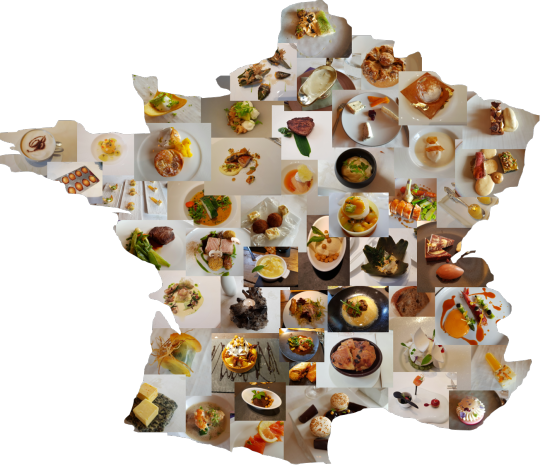
Three years ago, after long discussions with my family, I finally decided to change my career in order to pursue what had been a vague dream for me: to work in the culinary field. I had always been inspired by fine dining and carefully prepared beautiful dishes, so I decided to go for French cuisine. Before my final move to Canada, me and my family decided to experience real French cuisine in France and planned a Gourmet Trip for about 50 days. We went to France in April 2019, starting from Paris, visiting Nice, Marseille, Lyon, Dijon, Strasbourg, Reims, Rouen, Tours, Bordeaux, and again Paris.
This edited photograph is the summary of the gourmet experience I had during the trip. It illustrates distinguished dishes I had in Michelin starred restaurants as below. I edited the photograph of each dish from the course menu as a collage in the form of the map of France. I didn't edit the photograph itself except for size as it was my intention to show the originality. I wanted to create an image which symbolizes the importance of the trip to me. The records of the trip is still feeding me in terms of inspiration and ideas. Whenever I have to think of something creative, I look into the photographs of the dishes and remember what kind of ingredients it had, how it tasted, how it went with the wine. Differences in each restaurant, not only the dishes but also in style, atmosphere and characteristics, is giving me a good starting point to brainstorm. It has helped me a lot during my studies and was also an ultimate guide in forming my future career in detail. This edited photograph displays one of the greatest source of my ideas in the form of France.
Les Climats, Paris (11 April 2019)
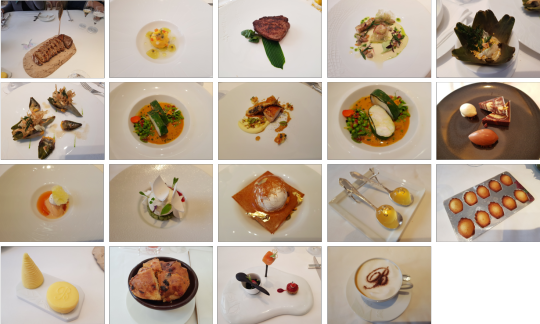
Epicure in Le Bristol, Paris (14 April 2019)

Les Terrasses de Lyon, Lyon (30 April 2019)
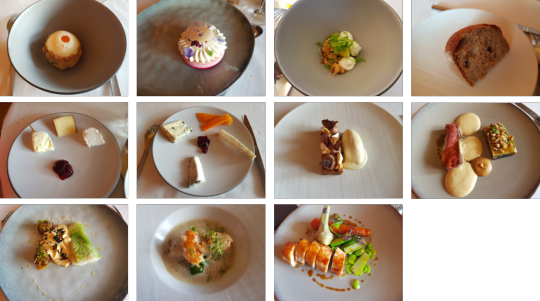
Le Bistro du Bord de l’Eau, Bourgogne (2 May 2019)

L’auberge d’ill, Illhaeusern near Strasbourg (4 May 2019)

I do not think that the audience will be misguided by my final image. I did not edit the original except for the size as it was my intention to show the originality of each photograph. I wanted to illustrate many photographs in one image but not in an overwhelming manner. That is why I chose to do a collage. My work was to let the audience know what I had experienced in France in a way that minimizes misleading interpretations. I expected the final image to be perceived more as a real moment rather than art. The original photographs will be more informative and serve as a good substitution of the final work as details can be seen.
My originals can be definitely used as press photographs. These are documentary photographs which purpose was purely to capture the reality as it is. In addition, the final work could also be used in the press as I did zero alteration to the original photographs except that it was cropped to the shape of the map of France and there would be not much room for misguidance by the audience. I believe the main purpose of news media is to provide the audience with information so that they can take what they need from this. Therefore in news media photographs based on reality should be used only. The photographs should be taken straightforwardly. Moreover I think that photographs used for the press should also have only one intention which is to document the reality as it is rather than to intend making changes. Every photograph has a different perception to reality and the slightest intention can change the way how the photography is taken. It is the audience who should interpret the photographs in their own context.
I believe that the main difference between art and press photography is about how the work is interpreted. Both can have intentions, whether it is to display a certain message or document the reality. However in terms of interpretations, it is important that press photography has only one or none interpretation but showing the reality, whereas it is conceived as art when everyone perceives the work in a different way.
In early days when photography was first introduced to the world, it was used to capture and document the world as it is. However in the late 1800s, pioneers such as Oscar G. Rejlander and Henry Peach Robinson started to use photographs to create art. Especially Henry Peach Robinson manipulated photographs using it as a method to art leading to the movement called ‘Pictorialism’ (https://www.britannica.com/technology/Pictorialism). The Pictorialism movement, which emphasizes the beauty of subject matter, tonality, and composition rather than the documentation of reality, was further developed by photographs such as Alfred Stieglitz.
While some declared their photography to be an art, others went to the complete other direction. As Charles Caffin stated, “there are two distinct roads in photography – the utilitarian and the aestshetic: the goal of the one being a record of facts, and the other an expression of beauty.” (Galassi, 2000, p.11) Their purpose was to document the reality and went to battlefields and wars. One of the first photographs was Robert Fenton. Later photographs recorded everyday life such as Jacob Riis, Lewis Hine, and Dorothy Lange.
I believe photography is a very special form of art and documentation. It has to be approached carefully regarding its intention. It is mostly perceived as a mean to capture the reality as it is. That is why it is widely used to create a specific image to the audience. The way a photography is displayed can impact the society and used as propaganda. We have seen many times nowadays how a photograph was misleading, spreading fake news, such as the case of Eric Tucker, whose twitter went viral with false information. (https://www.nytimes.com/2016/11/20/business/media/how-fake-news-spreads.html) As mentioned before just because it is photography we tend to believe that it shows the reality. However nowadays manipulation and editing photography is easier than ever and it is more spreading fast through SNS. It is now an important job for the audience to determine whether they can believe the photography as documentary or not, as well as how to interpret the work.
0 notes
Text
If you're bored, you're boring

Dear Jennifer June,
I follow you on Instagram, Facebook and twitter. You seem so down to earth and fun, even now, during this global disaster. I don't know how you do it!
Sorry for writing about something so depressing, I'm sure you have more interesting things to do than read this, but I'm having a hard time coping with this whole Corona Virus thing and you're basically my idol and there's nobody's advice I would cherish more than yours at a time like this.
It's hard enough living alone in this 3 story house, with nobody to talk to but my extraordinarily independent, mute, non-shedding, hypoallergenic cat, and nothing to do but play my baby grand piano, cook in my Wolfgang Puck inspired kitchen, and watch the plants in the solarium grow, without having to try to make sense of all the contradicting political and public service announcements on the news - on top of it all.
How do you stay so grounded and levelheaded during this crisis?
Anxious and alone, with nobody to share any of my wine with,
Samantha
P.S. I love your hair like that. You’re so pretty.
Dear Samantha,
Thank you so much for following me, and for your very kind words. I know that times like these can be very trying for anyone, and I honestly can't imagine how hard it must be for you to have all that empty quiet space to occupy all by yourself. The solarium alone sounds dreadful. I don't know if they will be of any use to you but here are 10 of the tools that have kept me calm, reflective and mentally grounded over the last few weeks.
Regular exercise - At least 4 times a week (weight training, cardio, stretching etc.)
Ritual - meditation, prayer, lighting candles, manifesting and projecting feelings of love and positivity for others, iChing, vision cards, visualizing acts of kindness etc...
Weekly check-ins with a fabulous therapist who reminds me to honour all of my feelings and be true to myself.
Minimum of 90 minutes daily gentle hand-picking of individual cat hairs out of every single inch of fabric/carpet/my body that I can find.
Poking my lettuce seedlings with a chopstick several times a day to "check" if they're growing.
Robert Mondavi Private Selection Cabernet Sauvignon Bourbon Barrels
Sartori Valpolicella Superiore
True Zin Puglia
Boisseaux-Estivant Réserve de la Chèvre Noire Bourgogne
Santa Julia Biologique Cabernet-Sauvignon Mendoza
Hope this helps!
JJC
Dear Jennifer June,
I've been to pretty much every single show you've ever done, and I love how funny you are. Everything you say on stage is so relatable even though you're obviously cooler, smarter and prettier than me. I got 3 cats and 1 dog because of you and I named them Phoebe, Flo, Willow and Nina, just like yours! But not in a creepy way.
Anyway, enough about me, but not really because I'm writing to you about me, because this quarantine vibe has me so down, I can't take it anymore. Ugh, Montreal is supposed to be the city of lights, or the city that never sleeps or whatever but I'm so lonely and bored, I literally almost thought about inviting my pharmacy delivery guy in for a drink yesterday when he came to deliver my topical rash ointment. You post the coolest stories on IG and you seem to be actually having fun. What do you do all day? How are you not dying of boredom right now?
PS Prescription guy - cute a f
Bored Becky
Dear Bored Becky,
Thank you so much for the kind words. I'm so glad you enjoy the shows. I'll be honest with you Becky; I have never once been bored in my adult life. I am actually fortunate enough to be able to work from home at the moment. I also have many projects on the go at all times. I love spending time with my family, listening to music, reading, and cooking. I also try to truly savour the rare moments that I get to just sit back and relax, whether it's in an Epsom salt bath, in a pile of blankets and cats (hair) on the sofa, or in a pool of my own nap drool /cry-orgasm-tears at the foot of the basement stairs.
I think that first, it's important for you to ask yourself, are you truly bored? Or are you feeling something else. Possibly, what you're feeling is avoidant. Maybe you're trying to procrastinate. Perhaps you're simply paralyzed with terror because the whole world has the fucking plague and people are smashing into each other in the streets like a swarm of contagious germ feast zombies.
Or maybe you're truly bored, Becky. And if you are....
Well, I don't want to be the jerk who says "If you're bored, you're boring" but I am, and it's true.
Seriously Becky, there are 22 different species of squirrel (in Canada) to post photographs of on Instagram,
165 shows on Netflix,
over 100 knitting stitches you can learn,
19054 different red wines at the SAQ,
millions of bananas that have not yet been baked into loaves of bread,
and 64 editions of Guinness World Records, compiling thousands of really fun, super safe feats for you attempt to break, from the comfort of your own home, including heaviest weight lifted by human beard, most apples crushed with the bicep and longest fingernails grown by a woman.
Hope this helps!
JJC
Dear Jen,
First:
You’re hilarious and I LOVE your dog.
Second:
I have a never-ending to-do list that I always say I don't have enough time to tackle. Thanks to the global pandemic, I am currently unemployed and under quarantine, which means that I have all the time in the world. I don't know why, but for some reason, I can't seem to get my shit together and do any of the things on my list. I basically just scroll through Instagram, watch television, drink wine and bake cookies.
I feel so lazy, I'm even embarrassed to be sending this to you.
I mean, I know that this kind of life changing event is enough to cause anybody trauma and make them feel creatively blocked, if not paralyzed. And I get that I should try to be self-compassionate and realistic about what I my limitations are under these times of great stress, but I can't help but feel a little bit guilty for not being able to do more.
Is there something wrong with me?
Shauna
Dear Shauna,
I think it's super important to remember that despite all the extra time you might have on your hands, it can be difficult to find inspiration for anyone right now.
The fear of the unknown, being inundated with a storm of anxiety-inducing news and so much contradicting information that leaves us entirely confused as to whether to go for walks or not go for walks, wear masks or not wear masks, stay 6 feet from people or 6 meters from people etc... It's a lot and can be really demotivating and even completely draining.
That having been said...
Get off the damn sofa and do the shit on your god damn list. If months go by and you come out of this with nothing done but 15 new pounds gained on your lazy ass, you're going to fucking hate yourself.
Study your damn Italian, post the dumplings on your vegan web site and do those stupid stair push-ups every stupid day or you will keep crying every time you can't do more than 10 of them.
Oh! And write your book already!!!
You have time to send 86 memes back and forth with your kids and post pictures of squirrels on Instagram every single day, sew 4 pairs of pyjamas, bake cookies you don't want to eat, watch every single episode of Game of Thrones in under 2 weeks, set up a photography corner in the basement that you don't use, and try all 19054 different red wines they sell at the SAQ, meditate, pray, light candles, manifest and project feelings of love and positivity for others, throw the iChing, pull vision cards, and visualize acts of kindness, and write not 1, not 2, but 3 drippy whiney love songs that you'll never let anybody hear because they're "not funny", "not done", and "not good enough", but you can't write a single chapter for your book? Are you kidding me right now? Jen seriously! Get it the fuck together.
Hope this helps!
PS My dog smells like rotting Doritos.
JJC
Read the full article
0 notes
Text


AVASSALADORA SAISON 2019/20 DA ÓPERA DE PARIS;
A FRANÇA SUPERPODER DA CULTURA ! : Stephen Lisser despede-se « en grandeur « 19 óperas muitas novas produções elencos com as principais estrelas .mundiais e dois ciclos completos do Anel de Wagner com solistas de luxo , Alem dos 100:milhões de euros do Ministerio da Cultura Francês admiro o trabalho colossal para programar algo desta dimensão . Transcrevo o programa difundido pela Ópera Wire
« The Opéra National de Paris has announced its 2019-20 seasons which will feature a total of 19 operas and the entire Ring Cycle in an all-new production.
Bellini’s “I Puritani” opens the season in a production by Laurent Pelly. Elsa Dreisig takes the leading role with Javier Camarena and Francesco Demuro sharing the role of Arturo. Riccardo Frizza conducts the production which also stars Igor Golovatenko and Alexander Tsymbalyu
Performance Dates: Sept. 7-Oct. 5, 2019
Pretty Yende and Nino Machaidze headline a new production of Verdi’s “La Traviata” by Simon Stone. Benjamin Bernheim and Atalla Ayan alternate as Alfredo, while Ludovic Tézier and Jean‑François Lapointe share the role of Germont. Michele Mariotti conducts.
Performance Dates: Sept. 12-Oct. 16, 2019
Ana Maria Martínez and Dinara Alieva share the title role in Puccini’s “Madama Butterfly” with Giorgio Berrugi and Dmytro Popov alternating as Pinkerton. Marie-Nicole Lemieux and Eve Hubeaux share the role of Suzuki with Giacomo Sagripanti conducting.
Performance Dates: Sept. 14-Nov. 13, 2019
Rameau’s “Les Indes Galantes” gets a new production with Clément Cogitore directing and Victor García-Alarcón conducting. Sabine Devieilhe, Jodie Devos, Julie Fuchs, Mathias Vidal, Stanislas de Barbeyrac, Alexandre Duhamel, Edwin Crossley-Mercer, and Florian Sempey star in the production.
Performance Dates: Sept. 27-Oct. 15, 2019
Roberto Alagna, Aleksandra Kurzak, Anita Rachvelishvili, Étienne Dupuis, Vitalij Kowaljow, and René Pape headline a revival of Verdi’s “Don Carlo.” Nicole Car and Michael Fabiano also star in the leading roles with Fabio Luisi conducting.
Performance Dates: Oct. 25-Nov. 23, 2019
Reimann’s “Lear” returns with Bo Skovhus in the title role, Evelyn Herlitzius as Goneril, Gidon Saks as Frankreich, and Annette Dasch as Cordelia. Fabio Luisi conducts.
Performance Dates: Nov. 21-Dec. 7, 2019
Barrie Kosky directs a new production of Borodin’s “Prince Igor” with Philippe Jordan conducting. Elena Stikhina, Anita Rachvelishvili, Pavel Černoch, and Evgeny Nikitin lead the all-star cast.
Performance Dates: Nov. 28-Dec. 26, 2019
Sondra Radvanovsky stars in Bellini’s “Il Pirata” alongside Michael Spyres and Ludovic Tezier. Bel Canto specialist Riccardo Frizza conducts the concert performance.
Performance Dates: Dec. 16-19, 2019
Lisette Oropesa headlines a revival of Rossini’s “Il Barbiere di Siviglia” with Xabier Anduaga, Florian Sempey, Andrzej Filonczyk, and Krzysztof Bączyk. Carlo Montanaro conducts Damiano Michieletto’s production.
Performance Dates: Jan. 11-Feb. 12, 2020
Ravel’s “L’Enfant et les sortileges” will be showcased with Debussy’ ballet “L’Apres-midi d’un Faune.” The opera will be part of the Academie showcase.
Performance Dates: Jan. 20-29, 2020
Robert Carsen’s classic production of “Les Contes d’Hoffmann” will star Michael Fabiano in the title role. He is accompanied by Jodie Devos, Ailyn Perez, and Veronique Gens as his three muses and Gaelle Arquez as Nickclausse. Laurent Naouri plays the four villains, while Mark Elder conducts.
Performance dates: Jan. 21-Feb. 14, 2020
Boesmans’ “Yvonne Princesse de Bourgogne” will star Beatrice Uria-Monzon, Laurent Naouri, and Dörte Lyssewski in the title role. Susanna Mälkki conducts the production by Luc Bondy.
Performance Dates: Feb. 26-March 8, 2020
Pretty Yende and Sofia Fomina star in a new production of Massenet’s “Manon” directed by Vincent Huguet. Benjamin Bernheim and Stephen Costello share the role of Des Greiux with Ludovic Tézier and Roberto Tagliavini rounding out the cast. Dan Ettinger conducts.
Performance Dates: Feb. 29-April 10,2020
Mozart’s “Don Giovanni” stars Luca Pisaroni, Jacquelyn Wagner, Stéphanie d’Oustrac, Philippe Sly, Zuzana Marková, and Alexander Tsymbalyuk. Philippe Jordan conducts the production by Ivo van Hove.
Performance Dates: March 21-April 24, 2020
Anna Netrebko stars in David McVicar’s production of “Adriana Lecouvreur” alongside Yusif Eyvazov and Ekaterina Semenchuk. Giacomo Sagripanti conducts a cast that also includes Zeljko Lucic. Elena Stikhina also stars in the title role for two performances.
Performance Dates: April 27-May 12, 2020
“Boris Godunov” takes the stage with René Pape in the iconic title role. Other cast members include Evdokia Malevskaya, Rusan Mantashyan, Elena Zaremba, and Andreas Conrad among others. Michael Schønwandt conducts a production by Ivo van Hove.
Performance Dates: May 23-June 14, 2020
Verdi’s “Rigoletto” will feature Frédéric Antoun as the Duke, Zeljko Lucic as Rigoletto, and Elsa Dreisig as Gilda. Speranza Scappucci conducts a production by Claus Guth.
Performance Dates: June 2-June 21, 2020
Ermonela Jaho, Elena Stikhina, and Marina Costa-Jackson will rotate the role of Mimì in “La Bohème.” As Rodolfo, audiences will get a chance to see Francesco Demuro, Vittorio Grigolo, and Benjamin Bernheim. Julie Fuchs and Elena Tsallagova will each be Musetta while Lucas Meachem and Gabriele Viviani will be Marcello. Lorenzo Viotti conducts the production by Claus Guth.
Performance Dates: June 13-July 5, 2020
Mozart’s “Così Fan Tutte” will feature Jacquelyn Wagner, Stephanie Lauricella, Stephen Costello, Philippe Sly, Paulo Szot, and Ginger Costa-Jackson. Antonello Manacorda conducts.
Performance Dates: June 19-June 28
Ring Cycle
Ring Cycle
Calixto Bieto is set to direct a new production of Wagner’s Ring Cycle with an all-star cast.
“Das Rheingold” will star Iain Paterson as Wotan, Lauri Vasar as Donner, Ekaterina Gubanova as Fricka, Anna Gabler as Freia, while “Die Walkure” will be headlined by Jonas Kaufmann as Siegmund, Eva-Maria Westbroek as Sieglinde, Martina Serafin in the role of Brünnhilde, Ekaterina Gubanova as Fricka, Paterson as Wotan, and John Relyea as Hunding.
In the third installment, “Siegfried,” Paterson will take on the Wanderer with Julie Fuchs as the Waldvogel, Martina Serafin as Brünnhilde, and Andreas Schager in the title role.
“Gotterdämmerung” will star Anna Gabler as Gutrune, Ricarda Merbeth as Brünnhilde, Sarah Connolly as Waltraute, Johannes Martin Kränzle as Gunther, and Schager as Siegfried.
Philippe Jordan conducts the entire Ring Cycle.
Das Rheingold: April 2-15, 2020
Die Walkure: May 5-27, 2020
Siegfried: Oct. 10-18, 2020
Gotterdämmerung: Nov. 13-21, 2020
Complete Cycles: Nov. 23-28, 2020 & Nov. 30-Dec. 6, 2020
Concerts
Jordan and Nina Stemme will team up for a concert performance that features Wagner’s Wesendonck Lieder and the Prelude and Liebestod from “Tristan und Isolde.”
Performance Date: Oct. 24, 2019 & Oct. 25, 2019
Matthias Goerne sings Mahler’s Ruckert Lieder with Philippe Jordan conducting. The program also includes Mahler’s fifth symphony.
Performance Date: March 11, 2020
folder_openTagged in: 2019-20 season, Ailyn Perez, Aleksandra Kurzak, ana maria martinez, Anita Rachvelishvili, anna netrebko, Beatrice Uria-Monzon, Elsa Dreisig, Ermonela Jaho, Francesco Demuro, Gaëlle Arquez, javier camarena, Jonas Kaufmann, Julie Fuchs, Lisette Oropesa, Ludovic tezier, marie-nicole lemieux, Michael Fabiano, nicole car, Nina Stemme, Nino Machaidze, Opera de Paris, Paulo Szot, Pretty Yende, Rene Pape, Roberto Alagna, Sabine Devieilhe, Veronique Gens, vittorio grigolo, yusif eyvazov »
0 notes
Text
An absence of family strife
Their marriages were generally fruitful and, what was equally important, their sons were usually loyal, or at least obedient. There are remarkably few instances of rebellion against paternal authority. Robert the Pious did take arms against his father, probably in 996, and his own two sons Henri and Robert united against him in 1030; but these were isolated instances. The only other example that can be offered is the quarrel between Philip I and the future Louis VI, which may be attributed to the malicious intervention of the prince's stepmother, Queen Bertrada. If it demonstrates anything, it shows the patience and loyalty of Prince Louis under considerable provocation. No contemporary royal, or even noble, family, can show anything approaching so favourable a record in this respect.
The characters of the individual kings go some way towards explaining this absence of family strife. The Capetians were good husbands. Only two bastards are recorded for the fourteen kings of the dynasty: Isabella, daughter of Louis VI, who married Guillaume de Chaumont, and Pierre Charlot, the son of Philip Augustus and that 'damsel of Arras' whose name the chroniclers delicately omit. Only three scandals can be pointed to: the elopement of Philip I with Bertrada de Montfort, wife of Fulk of Anjou, on 15 May 1092; the estrangement of Philip Augustus and Ingeborg of Denmark in 1193; and the tragic episode of the daughters-in-law of Philip the Fair in 1314. The only excuse put forward for the first affair was the excessive obesity of the lawful queen ("praepinguis corpulentiae", according to William of Malmesbury); it would not be unfair to point out that the king himself, at the age of forty, was already very fat also. Dr Brachet has plausibly explained the behaviour of Philip Augustus as the consequence of the impact of a momentary anaphrodisia on a nervous system already strained by illness. Certainly, the adventure of the damsel of Arras apart, he does not appear to have led an irregular life. But we must look more closely at the third episode, which throws a vivid light on the moral values of the royal family.
Robert Fawtier - The Capetian Kings of France
#xi#xii#xiii#xiv#robert fawtier#the capetian kings of france#robert ii#henri i#robert i de bourgogne#philippe i#louis vi#bertrade de montfort#isabelle#pierre charlot#philippe ii#la demoiselle d'arras#philippe iv#berthe de hollande#marguerite de bourgogne#jeanne ii de bourgogne#blanche de bourgogne#ingeborg de danemark#foulques iv d'anjou
1 note
·
View note
Text
Constance d'Arles: resilient and determined
Hugh Capet, unsuccessful in his search for a Byzantine princess, arranged for his son Robert "the Pious" (so named for later acts of piety, rather than marital fidelity) to marry Rozala, the daughter of Berengar II of Italy and Countess of Flanders from her first marriage. She was considerably older than Robert, who divorced her within one year of his father's death. He had been living openly with Bertha of Burgundy (d.1035), Countess of Burgundy, and also a widow. However, Bertha was Robert's cousin: Pope Gregory V refused to sanction their marriage on the grounds of consanguinity, and excommunicated Robert. Robert repudiated Bertha around 1004; she remained unmarried and a force to be reckoned with.
In 1001, Robert married Constance of Arles (d.1034). She was a formidable, ambitious woman and their marriage, unsurprisingly, was difficult. Bertha's family opposed her, and Robert's advisors despised Constance because she favored southern customs and her Provençal family. When Hugh of Beauvais, close advisor to the king, suggested that Robert repudiate her in 1007, he was murdered by knights of Constance's kinsman, perhaps at her order. Her ambitions alienated the chroniclers of her day, who blamed her for several of the king's decisions and accused her of outrageous actions. In the account of a heresy trial of her former confessor, Constance struck out his eye with her staff. In 1010, Robert went to Rome, accompanied by his former wife Bertha, to seek permission to divorce Constance and remarry Bertha. His request was denied, he returned to Constance and together they had several children, with and against whom she plotted revolt against their father. At Constance's urging, their eldest son, Hugh Magnus, was crowned co-king with his father in 1017; after Hugh's death in 1025, Robert and Constance quarreled over which of their surviving sons should inherit. Despite his mother's protests, their second son, Henri, was crowned in 1027. Fulbert of Chartres wrote in a letter that he was frightened away from the consecration of Henri "by the savagery of his mother, who is quite trustworthy when she promises evil." Constance continued to encourage her sons to rebel, Robert agreed to their demands, and made peace until his death in 1031. Soon after that, Constance was at odds with both sons, Henri and Robert; she seized her dower lands and refused to surrender them to Henri's wife, Anna. Henri fled to Normandy, where he received aid, weapons and soldiers from his brother, returning to besiege their mother. However, Constance, ever wily and resilient, escaped, surrendering only when Henri swore to slaughter all the inhabitants of a town.
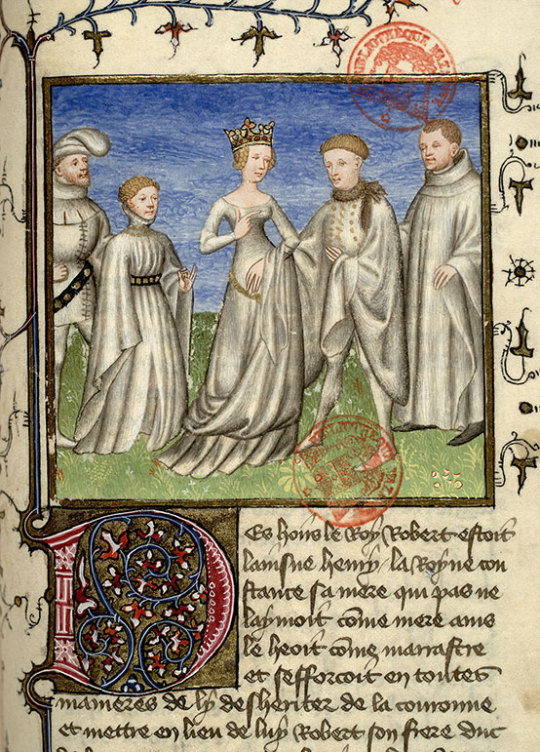
Despite this litany of malicious actions, contemporary critics of Constance also comment favorably on her concern for the royal treasury and her wise counsel to her husband. Her Provençal "foreignness" isolated her, and she struggled to balance her allegiance to both her natal and marital family. Seen in this light, many of her more notorious actions can be attributed to the absence of familial support and very real fears of repudiation. Penelope Adair argues convincingly that, given the limited resources at hand, Constance's efforts to preserve the royal treasury and her objections to alienation of royal property were "the well-founded concerns of a clear-sighted and determined royal consort."
Theresa Earenfight - Queenship in Medieval Europe
#x#xi#theresa earenfight#queenship in medieval europe#constance d'arles#bosonides#hugues capet#robert ii#rozala d'italie#berthe de bourgogne#hugues de beauvais#hugues de france#henri i#robert de bourgogne#fulbert de chartres#anne de kiev
1 note
·
View note
Photo
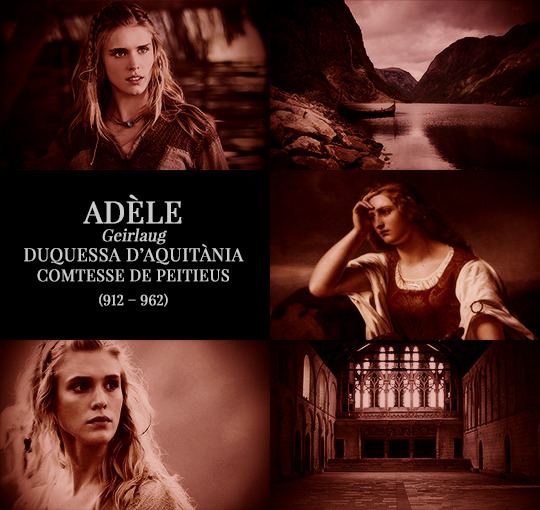
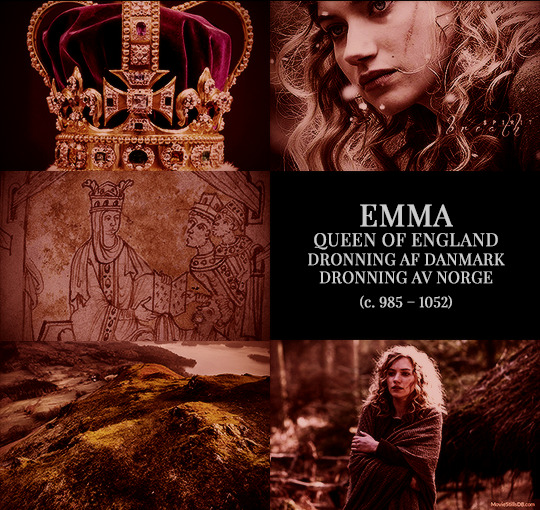
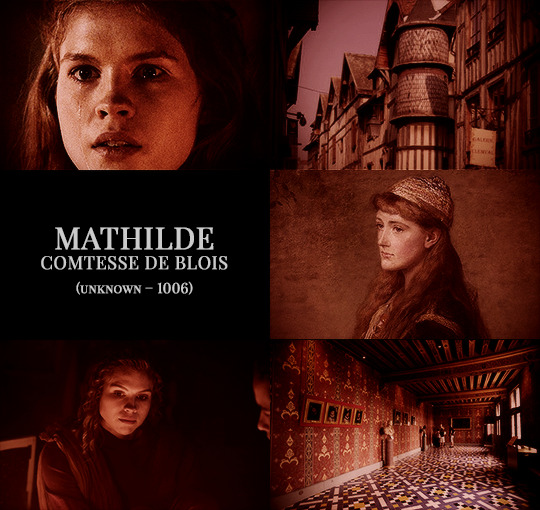

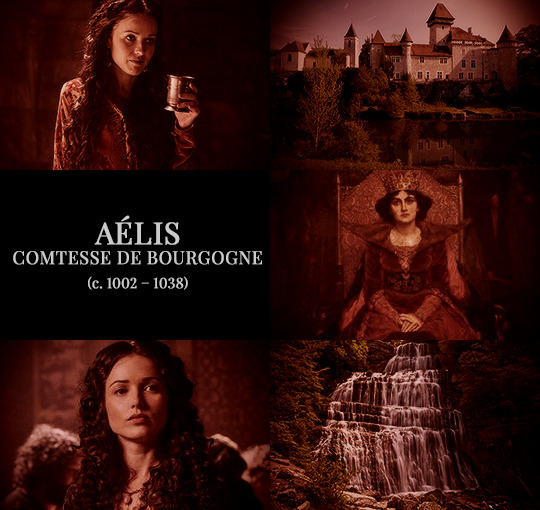
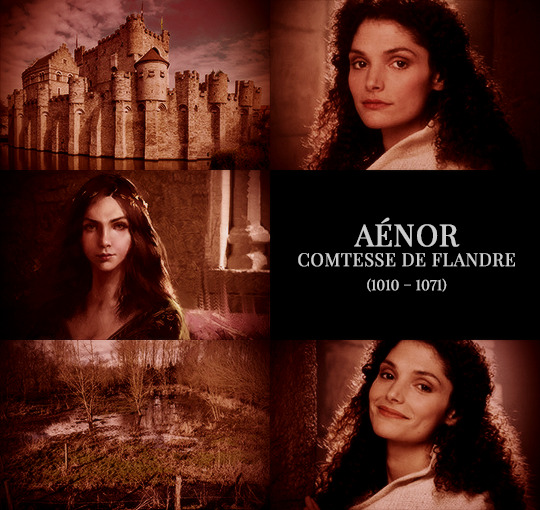
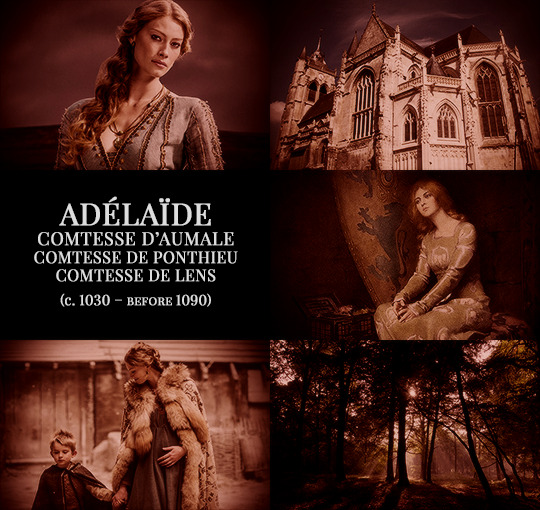
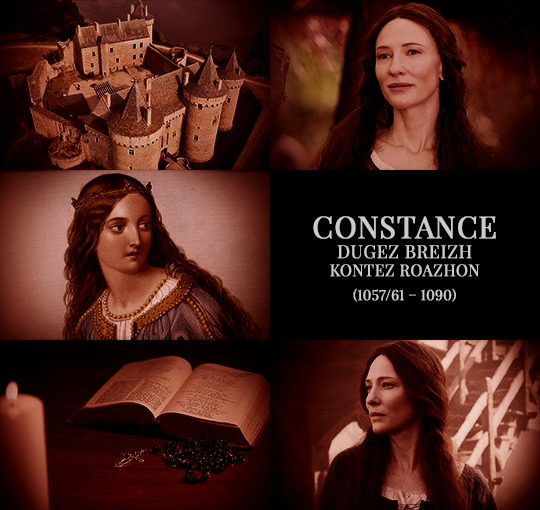
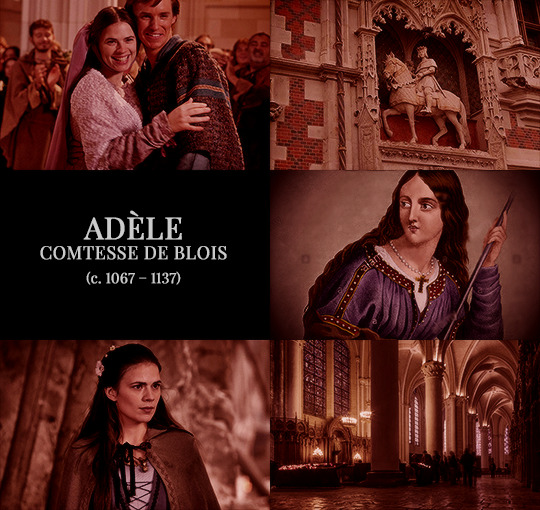

Women of the House of Normandy
Adèle, duquessa d’Aquitània. Daughter of Rollo, comte de Rouen and Poppa de Bayeux. Mother of Adelaïda de Peitieus, reine des Francs.
Emma, Queen of England. Daughter of Richard Ier, comte de Rouen and Gunnora. Mother of Godgifu, comtesse du Vexin and Gunhild af Danmark, Sacri Romani Imperatrix.
Mathilde, comtesse de Blois. Daughter of Richard Ier, comte de Rouen and Gunnora.
Havoise, dugez Breizh. Daughter of Richard Ier, comte de Normandie and Gunnora. Ancestress of Hawiz, dugez Breizh.
Aélis, comtesse de Bourgogne. Daughter of Richard II, duc de Normandie and Judit Breizh. Mother of Aubrée de Bourgogne, duchessa di Puglia e Calabria. Ancestress of Sibylle de Bourgogne, duchesse de Bourgogne; Emma de Hauteville; Adelaide di Savoia, reine des Francs; and Constanza de Castilla, reine des Francs.
Aénor, comtesse de Flandre. Daughter of Richard II, duc de Normandie and Judit Breizh. Mother of Judith de Flandre, Countess of Northumbria. Ancestress of Judith von Bayern, Herzogin von Schwaben.
Adélaïde, comtesse d’Aumale. Daughter of Robert Ier, duc de Normandie. Mother of Adélaïde de Ponthieu and Judith de Lens, Countess of Northampton. Ancestress of Maud of Huntingdon, Queen of Scots and Hawise, comtesse d’Aumale.
Constance, dugez Breizh. Daughter of William the Conqueror and Mathilde de Flandre.
Adèle, comtesse de Blois. Daughter of William the Conqueror and Mathilde de Flandre. Mother of Adèle de Blois, dame de Montlhéry; Lucie-Mahaut de Blois, Countess of Chester; Agnès de Blois, dame de Puiset; Alais de Blois, comtesse de Joigny; and Aénor de Blois, comtesse de Vermandois.
Mathilde, Sacri Romani Imperatrix. Daughter of Henry I of England and Edith-Mathilde of Scotland. Grandmother of Matilda of England, Herzogin von Sachsen und Bayern; Eleanor of England, reina de Castilla; and Joan of England, regina di Sicilia.
#house of normandy#medieval#historyedit#french history#english history#european history#women's history#history#royalty aesthetic#nanshe's graphics
134 notes
·
View notes
Photo
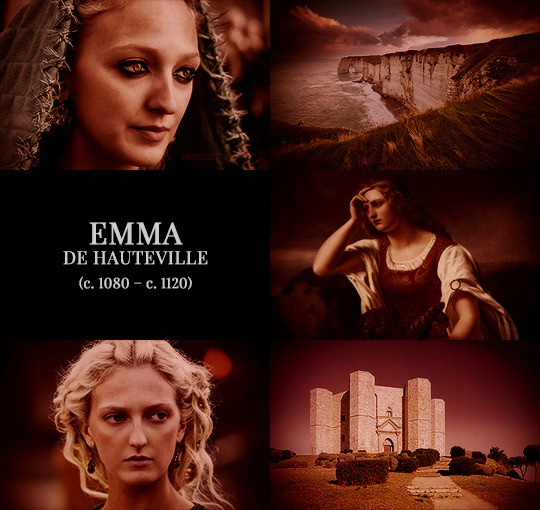


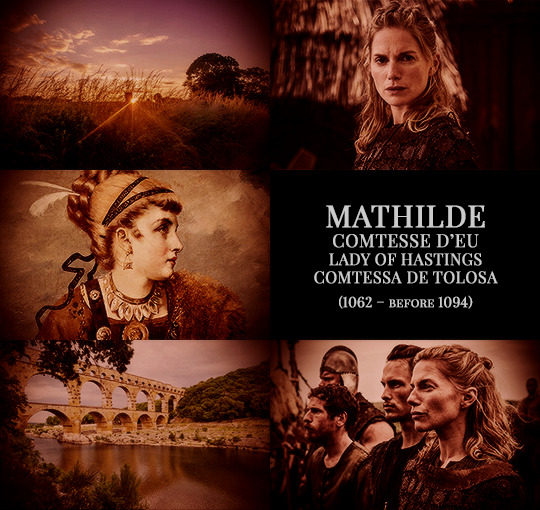
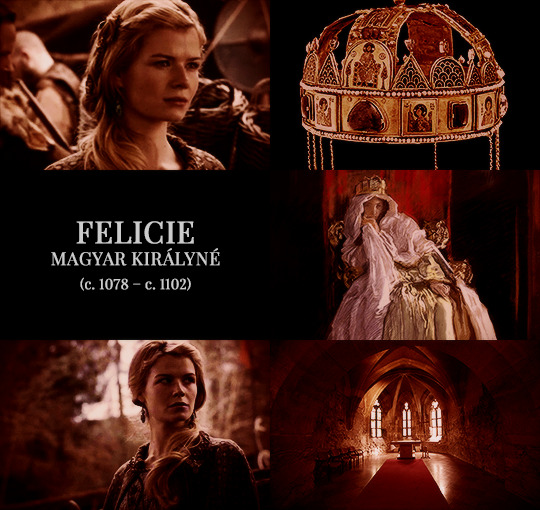
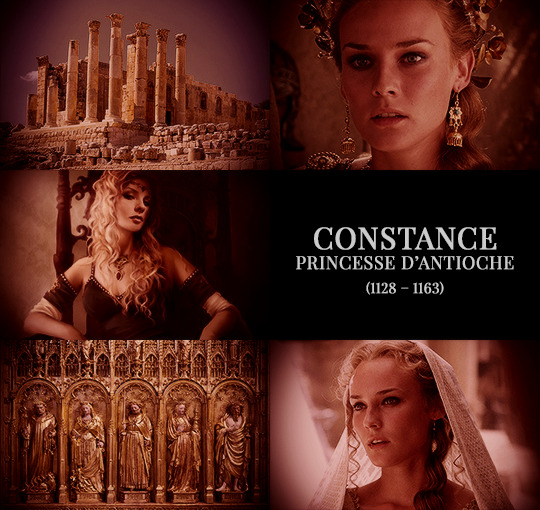
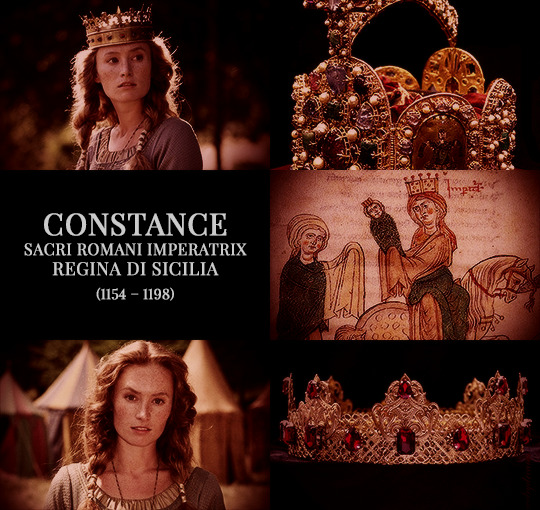


Women of the House of Hauteville
Emma de Hauteville. Daughter of Robert Guiscard and Aubrée de Bourgogne. Mother of Altrude de Hauteville, principessa di Salerno. Grandmother of Marie de Hauteville, comtesse d’Édesse.
Mathilde, comtessa de Barcelona. Daughter of Robert Guiscard and Sichelgaita di Salerno. Grandmother of Ximena d’Osona, comtessa de Fois; Berenguera de Barcelona, reina de Castilla; Estefania de Barcelona, comtessa de Bigorra; Almodis de Barcelona; and Ermengarda, vescomtessa de Narbona.
Sibylle, comtesse de Roucy. Daughter of Robert Guiscard and Sichelgaita di Salerno. Mother of Mabel de Roucy, comtesse de Jaffa.
Mathilde, comtesse d’Eu and comtessa de Tolosa. Daughter of Roger Bosso and Judith d’Évreux.
Félicie, magyar királyné. Daughter of Roger Bosso and Éremburge de Mortain. Mother of Árpád-házi Zsófia.
Constance, princesse d’Antioche. Daughter of Bohémond II, prince d’Antioche and Alix de Jérusalem. Mother of Marie d’Antioche, Byzantine Empress; Philippa d’Antioche, dame de Toron; and Agnès d’Antioche, magyar királyné.
Constance, regina di Sicilia. Daughter of Roger II of Sicily and Béatrice de Rethel. Mother of Holy Roman Emperor, Friedrich II.
Elvire, comtesse de Brienne. Daughter of Tancrède I of Sicily and Sibilla di Acerra. Mother of Marguerite de Brienne, comtesse de Sidon. Ancestress of Jacquette de Luxembourg, Duchess of Bedford.
Constance, dogaressa di Venezia. Daughter of Tancrède I of Sicily and Sibilla di Acerra.
#house of hauteville#medieval#historyedit#french history#italian history#european history#asian history#women's history#history#royalty aesthetic#nanshe's graphics
117 notes
·
View notes
Photo


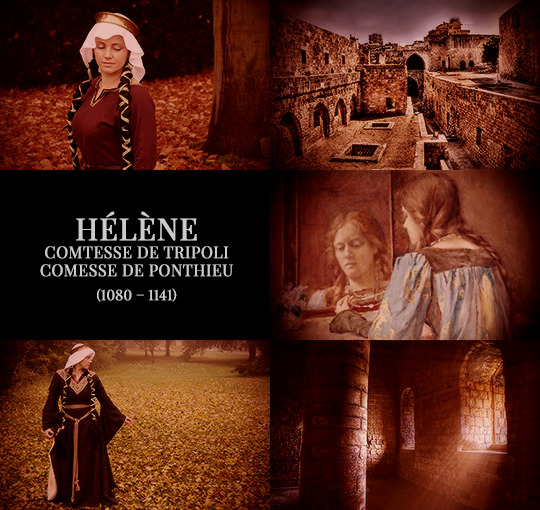



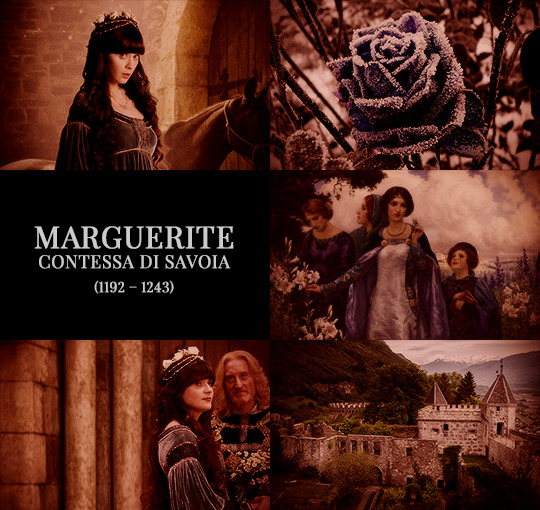
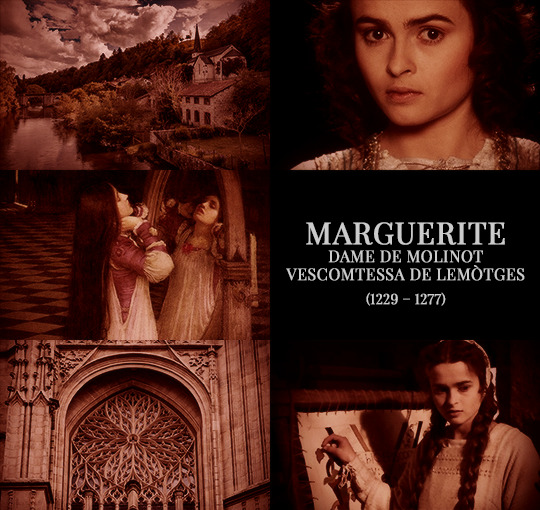
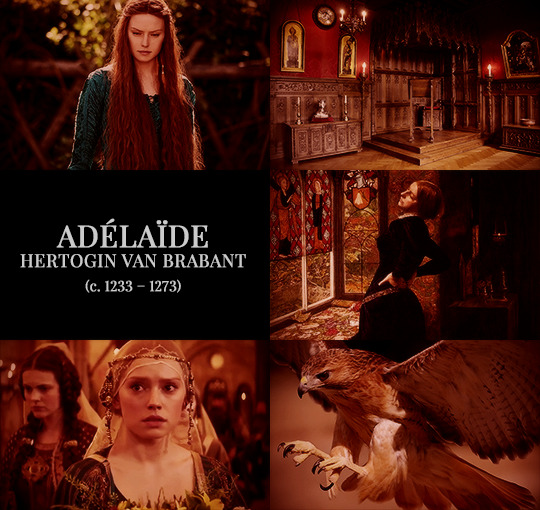
Women of the House of Burgundy aesthetic, part I
Constance, reina de León y de Castilla. Daughter of Robert Ier, duc de Bourgogne and Helie de Semur-en-Brionnais. Mother of Urraca I de León.
Hildegarde, duquessa d’Aquitània. Daughter of Robert Ier, duc de Bourgogne and Ermengarde-Blanche d’Anjou. Grandmother of Agnès d’Aquitània, reina d’Aragón. Great-grandmother of Alienòr d’Aquitània; Petronilha d’Aquitània, comtesse de Vermandois; and Peyronela d’Aragón.
Hélène, comtesse de Ponthieu. Daughter of Eudes Ier, duc de Bourgogne and Sibylle de Bourgogne. Ancestress of Isabel de Warenne, Countess of Surrey; Mélisende de Tripoli; Ela, 3rd Countess of Salisbury; and Jehanne de Dammartin, comtesse de Ponthieu.
Florine de Bourgogne. Daughter of Eudes Ier, duc de Bourgogne and Sibylle de Bourgogne.
Sibylle, regina di Sicilia. Daughter of Hugues II, duc de Bourgogne and Mathilde de Mayenne.
Mathilde, senhora de Montpelhièr. Daughter of Hugues II, duc de Bourgogne and Mathilde de Mayenne. Grandmother of Maria de Montpelhièr, reina d’Aragó.
Marguerite, contessa di Savoia. Daughter of Hugues III, duc de Bourgogne and Béatrice d’Albon, dauphine de Viennois. Grandmother of Costanza II di Sicilia.
Marguerite, vescomtessa de Lemòtges. Daughter of Hugues IV, duc de Bourgogne and Yolande de Dreux. Mother of Maria de Lemòtges, dugez Breizh. Grandmother of Jehanne de Penthièvre, dugez Breizh.
Adélaïde, hertogin van Brabant. Daughter of Hugues IV, duc de Bourgogne and Yolande de Dreux. Mother of Maria van Brabant, reine de France.
#house of burgundy#historyedit#french history#european history#women's history#history#royalty aesthetic#nanshe's graphics
95 notes
·
View notes
Photo


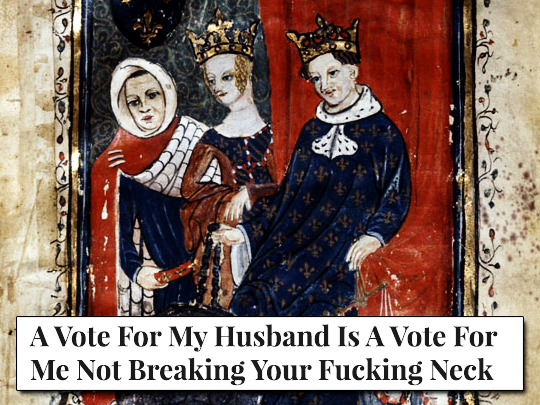


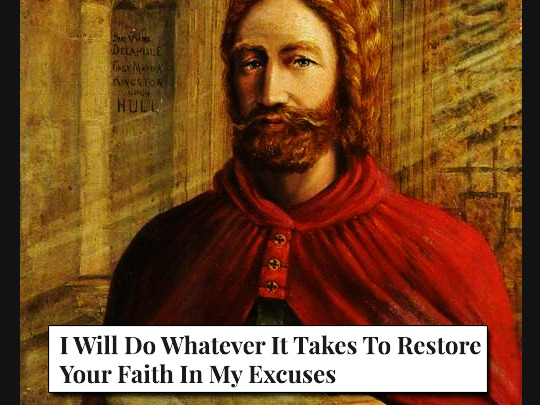




Hundred Years’ War (Edwardian phase) + The Onion headlines
#hundred years' war#medieval#historyedit#middle ages#the onion headlines#english history#french history#the onion#european history#history#nanshe's graphics
173 notes
·
View notes
Photo

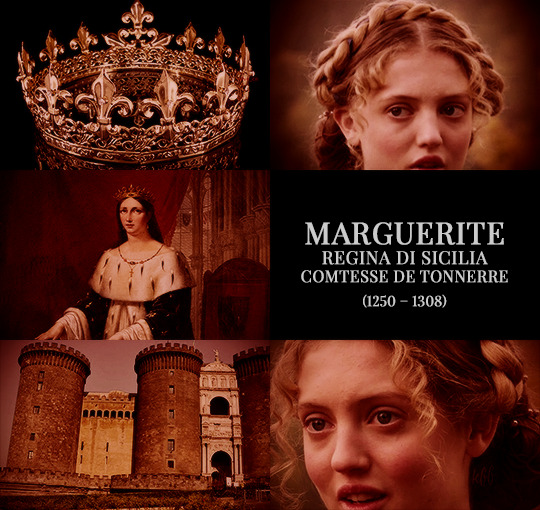
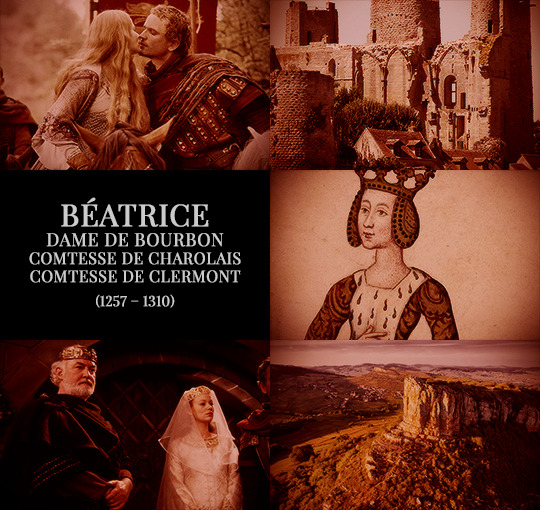

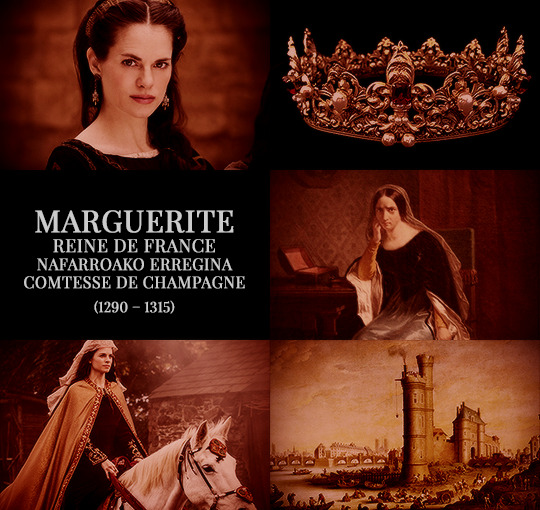
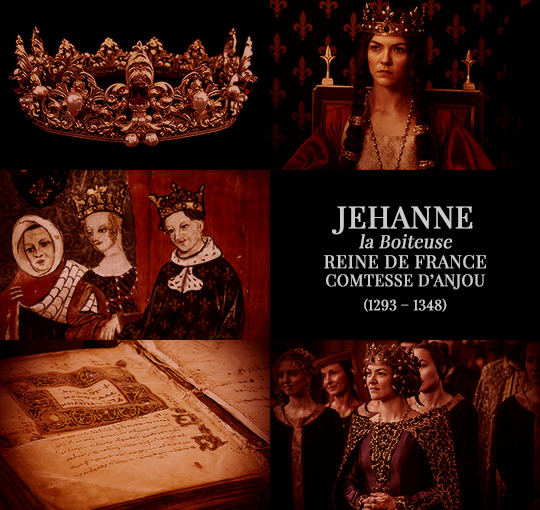
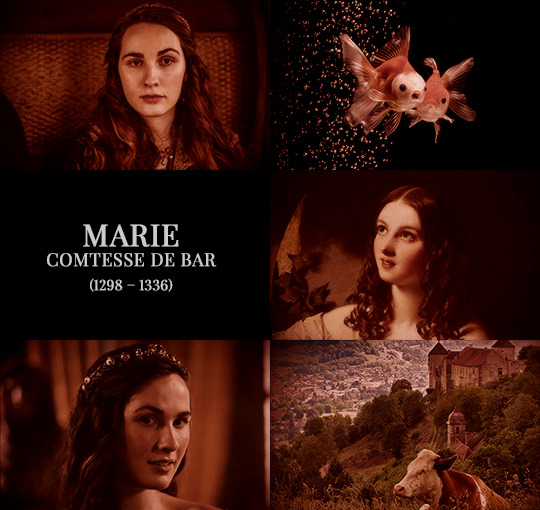
Women of the House of Burgundy aesthetic, part II
Yolande II, comtesse de Nevers. Daughter of Eudes de Bourgogne and Mathilde II de Bourbon, comtesse de Nevers. Grandmother of Jehanne de Flandre, dugez Breizh.
Marguerite, regina di Sicilia. Daughter of Eudes de Bourgogne and Mathilde II de Bourbon, comtesse de Nevers.
Béatrice, dame de Bourbon. Daughter of Jehan de Bourgogne and Agnès de Dampierre. Ancestress of Jehanne Ire d’Auvergne, reine de France; Jehanne de Bourbon, reine de France; and Blanche de Bourbon, reina de Castilla.
Blanche, contessa di Savoia. Daughter of Robert II, duc de Bourgogne and Agnès de France. Mother of Giovanna di Savoia, dugez Breizh.
Marguerite, reine de France. Daughter of Robert II, duc de Bourgogne and Agnès de France. Mother of Jehanne II de Navarre.
Jehanne, reine de France. Daughter of Robert II, duc de Bourgogne and Agnès de France. Grandmother of Jehanne de France, Nafarroako erregina; Marie de France, duchesse de Bar; and Isabelle de France, comtesse de Vertus.
Marie, comtesse de Bar. Daughter of Robert II, duc de Bourgogne and Agnès de France. Ancestress of Violant d’Aragó, duchesse d’Anjou and Jehanne de Bar, comtesse de Soissons.
#house of burgundy#historyedit#french history#european history#women's history#history#royalty aesthetic#nanshe's graphics
48 notes
·
View notes
Note
Hi, sorry to disturb you. I really like your capetian princesses aesthetic but I was wondering why lead you to leave some princess out? At first I thought it was just the one who died in infancy (or before starting their "own life") but then I noticed Yolande of France (Charles VII and Marie of Anjou's daughter) was missing so was her sister Jeanne of France... How do you choose the princesses you make aesthetic of? (sorry if this sound agressive it is not intended to)
Yolande and Jehanne aren't the only daughters of Charles VII missing. Radegonde and Catherine, comtesse de Charloias are, too. I originally intended to do all of the Capetian princesses who lived past childhood (with the exception of poor Marie Élisabeth - more of is known of her than most), but then realized what a daunting project that would be, so I started cutting out those about whom little is known beyond basic genealogical facts.
Jehanne, duchesse de Bourbon didn't make the cut because I haven't be able to find much information on her; Radegonde and Catherine, comtesse de Charloias because they died as teenagers; and Yolande because I stupidly skipped over her while browsing the wikipedia list of Charles VII's children. Other princesses omitted (all because of lack of information) were:
Hugues Capet — Gisèle, comtesse de Ponthieu and Hedwige, comtesse de Mons.
Robert II — Avoye, comtesse d'Auxerre and Constance, comtesse de Dammartin.
Philippe II — Marie, Hertogin van Brabant.
Louis IX — Marguerite, Hertogin van Brabant.
Philippe III — Blanche, Herzogin von Österreich.
Philippe V — Jehanne III, comtesse de Bourgogne; Isabelle, dauphine de Viennois; and Blanche, nun.
Charles IV — Blanche, duchesse d'Orléans.
Philippe VI — Jehanne, bethrothed to the future king of Aragon
Charles V — Catherine, comtesse de Montpensier.
8 notes
·
View notes
Photo


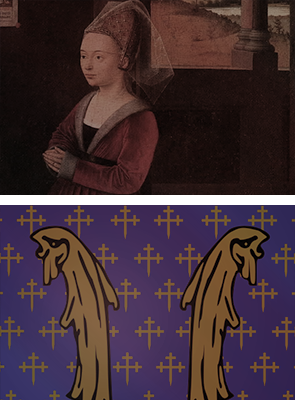

WOMEN’S HISTORY † JEHANNE DE BAR, COMTESSE DE MARLE ET DE SOISSONS (1415 – 14 May 1462)
Jehanne de Bar was the daughter and only child of Robert de Marle, comte de Soissons and Jehanne de Béthune, vicomtesse de Meaux. Through her father, she was the granddaughter of Marie Ire de Coucy. She was only a baby when her father was slain during the Battle of Agincourt and she became the heir to his titles and estates. In 1418, Jehanne’s mother remarried to Jehan II de Luxembourg, comte de Ligny, a steadfast supporter of the Burgundian cause and Henry VI of England’s claim to the throne of France. In fact, Jehan was the soldier who took custody of Jehanne d’Arc and Jehanne de Bar, her mother, and her stepfather’s elderly aunt took care for the teenage girl during her captivity. Jehanne and the two other Jehannes begged Jehan not to hand Jehanne d’Arc over to the English and instead ransom her back to Charles VII de France, but he ignored them and handed her over to the English for 10,000 livres.
On 16 July 1435, Jehanne married her stepfather’s nephew and heir, Louis de Luxembourg, comte de Saint-Pol, who was also the younger brother of Jacquette de Luxembourg. She and Louis had seven children, four sons and three daughters. Though not the staunch Burgundian his uncle was, Louis was not on good terms with Charles VII, though he was a close friend of the future Louis XI. However, after Louis XI became king, Louis became an ally of Charles le Téméraire de Bourgogne and Edward IV of England. What Jehanne thought of her husband’s political dealings is unknown and she died in 1462 before things really heated up. In 1475, Louis was arrested and executed by the order of Louis XI.
However, Jehanne and Louis were the grandparents of Marie de Luxembourg, the mother of Charles IV de Bourbon, duc de Vendôme (paternal grandfather of Henri IV de France) and Antoinette de Bourbon (grandmother of Mary, Queen of Scots and Catherine-Marie de Lorraine).
#jeanne of bar#house of luxembourg#french history#european history#women's history#history#women's history graphics#nanshe's graphics#medieval
7 notes
·
View notes